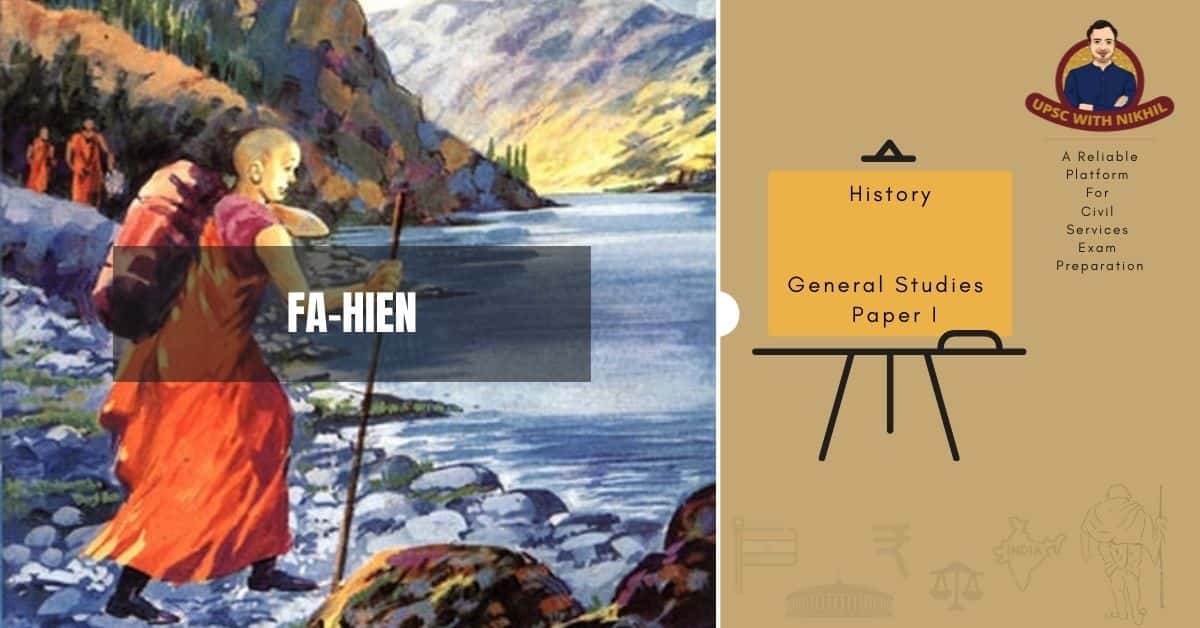Fa-hien
Fa Hien, a Chinese monk, travelled to India via Central Asia between 399 and 414 CE in search of better copies of Buddhist books.
Between 399 and 412, he travelled from China to India on foot, visiting sacred Buddhist sites in Central, South, and Southeast Asia to acquire Buddhist texts.
He crossed the Gobi Desert and arrived in Khotan, where he discovered numerous Buddhist monasteries. After that, he went to Shanshan. Kasagara and Tarter Pradesh Kasagara's ruler at the time was a Buddhist. As a result, he met Buddhist monks and discovered numerous monasteries. He then passed through the Pamir Plateau, Swat, and Gandhara Pradesh.
He arrived in India around 400 A.D. and stayed until 411 A.D. Peshawar, Taxila, Mathura, Kannauj, Sravasti, Kapilavastu, Sarnath, and many other places were among the places he visited. At the seaport of Tamralipti, he set sail for Ceylon (West Bengal). He spent two years in Ceylon (Sri Lanka) before returning to China via Jawa in 414 A.D.
His tone is that of a devout, learned, sensible, and occasionally hysterical pilgrim-traveller throughout. His track record is meticulous and accurate, and the majority of his positions can be traced back to him. He brought Buddhist texts and sacred images back with him. The rest of his life was spent translating and editing the scriptures he had gathered.
WE CAN LEARN THE FOLLOWING FROM HIS ACCOUNT:
•Faxian chronicled his travels in a book filled with early Buddhist accounts as well as the geography and history of a number of countries along the Silk Road as they were at the turn of the fifth century CE. In Middle India, he wrote about Taxila, Pataliputra, Mathura, and Kannauj.
•He had described Patliputra in great detail. According to him, during the reigns of Samudragupta and Vikramaditya, the city of Pataliputra was neglected, but during the reign of Chandragupta II, it was given top priority.
•He also mentioned the monks who were studying for their religious exams. Because the towns of Magadha were the largest in the Gangetic Plains, he wrote Magadha as Central India.

•Fa-hien didn't record anything specific about India's political situation. He didn't even mention Chandra Gupta II, under whose rule he must have spent more than five years. We can, however, infer something from his records.
•By writing about charitable institutions, rest houses, and free hospital services, he portrayed Chandragupta as the kindest ruler. People were so safe and secure at the time, he claims, that they didn't even lock their doors. People were set free during his reign, he said, and the king interjected himself very little into people's lives. Land revenue was the state's main source of revenue. The people had complete freedom to move from one land to the next. Monasteries, Sanghas, temples, and their property, as well as other religious endowments, were tax-exempt. The public highways were safe and secure, free of the threat of robbers and dacoits. The people were wealthy and happy with their lives. The public's morality was at an all-time high. The majority of the people were vegetarians who avoided eating meat and onions. They didn't drink or use other intoxicants. Only the Chandalas (Untouchables) who lived outside of cities hunted and fished and ate meat.
• The wealthy competed with one another in benevolence and righteousness. They established houses where charity and medicine could be distributed, as well as large donations to temples, monasteries, and Sanghas. All of this suggests that the people were wealthy, content, liberal, and morally simple.
• At the time, Buddhism and Hinduism were the most popular religions. There were many Buddhist monasteries in Mathura, and even government servants admired Buddhist monks. The emperor was a devotee of Vishnu, but he was also tolerant of other religions. Buddhism and Hinduism flourished side by side, indicating that the people were religiously tolerant.
• For nearly three years, Fa-hien lived in Pataliputra and studied Sanskrit. He explained that the Hinayana and Mahayana sects each had their own Sanghas, which provided education to students from all over India. Emperor Asoka's Palace also existed at the time, and Fa-hien speculated that "it might have been built not by men but by gods."
• The chariot-processions in this town also impressed Fa-hien. He stated that on the eighth day of the second month of each year, the people organise a large procession to earn images of the Buddha and the Bodhisattavas. The wealthy residents of Pataliputra had built a large hospital in the city, where the poor were given free medicines and food.
• According to him, India's internal and external trade was progressing, and Indians were embarking on sea voyages. India, he claimed, had trade relations with China, Southeast Asian and Western Asian countries, as well as Europe. India had ports like Cambay, Sopara, and Baroach on its western coast, while Tamralipti on its eastern coast was a well-known port from which Fa-hien sailed to Sri Lanka on an Indian ship.
Thus, while not sufficient in and of itself, Fa-account hien's provides us with some useful information about the social, economic, religious, and moral conditions of the Gupta people in India.


